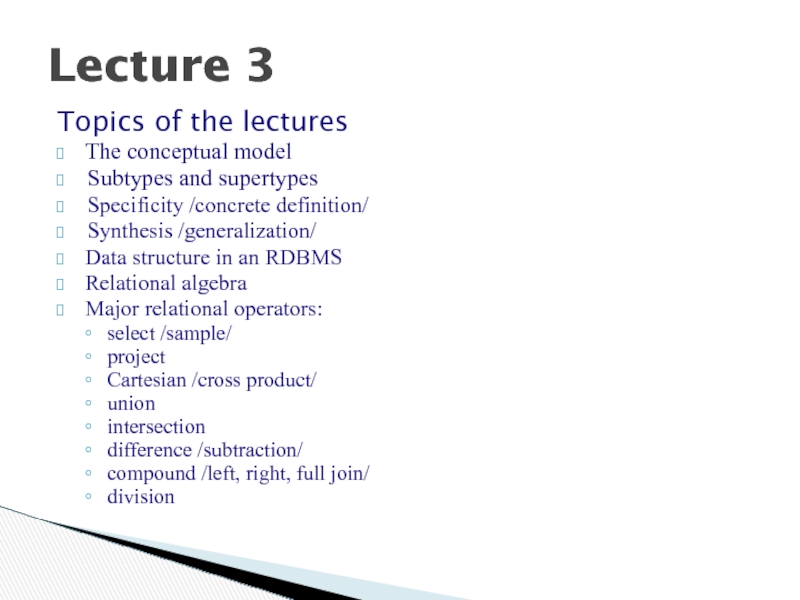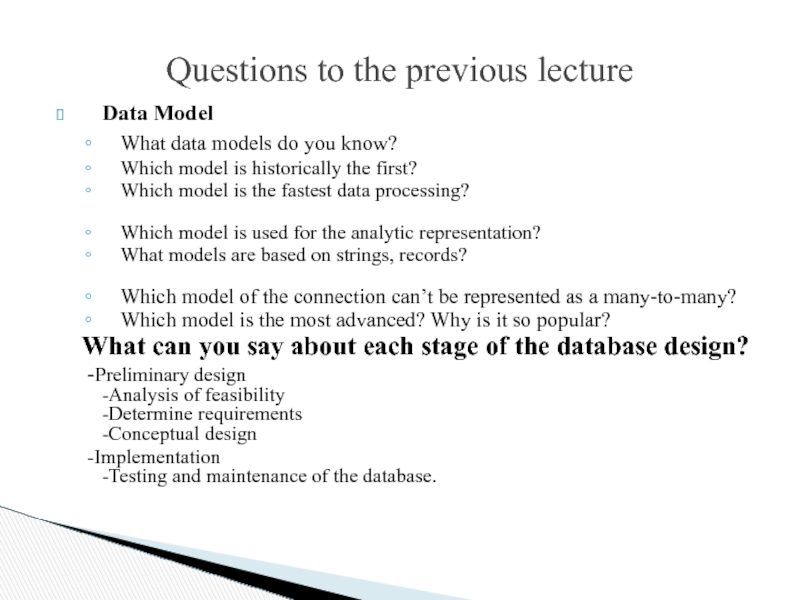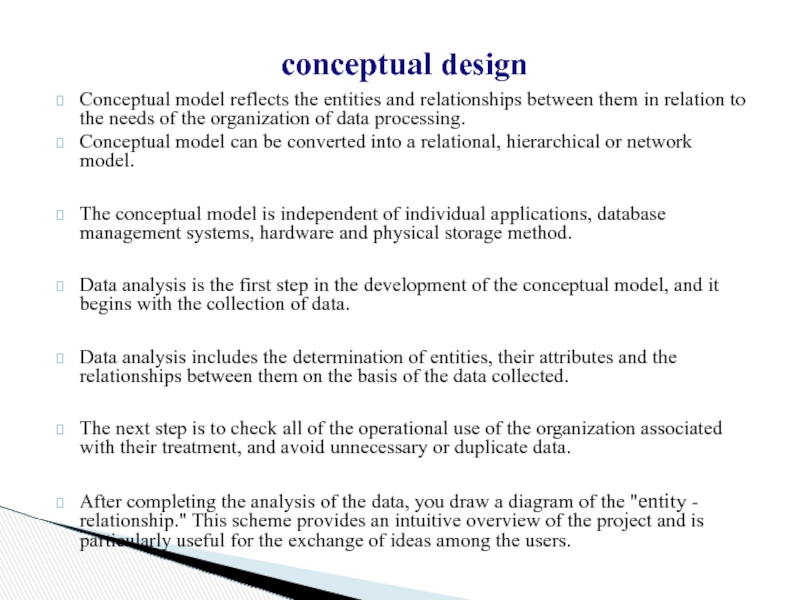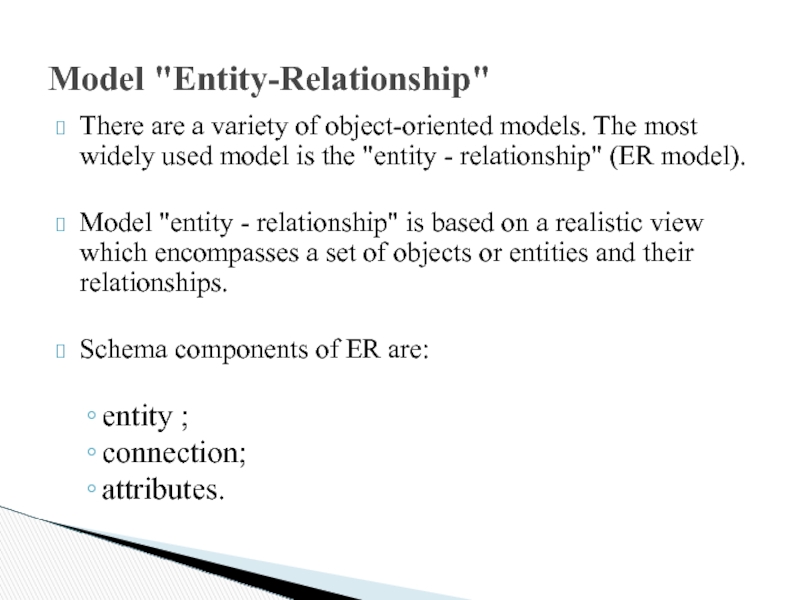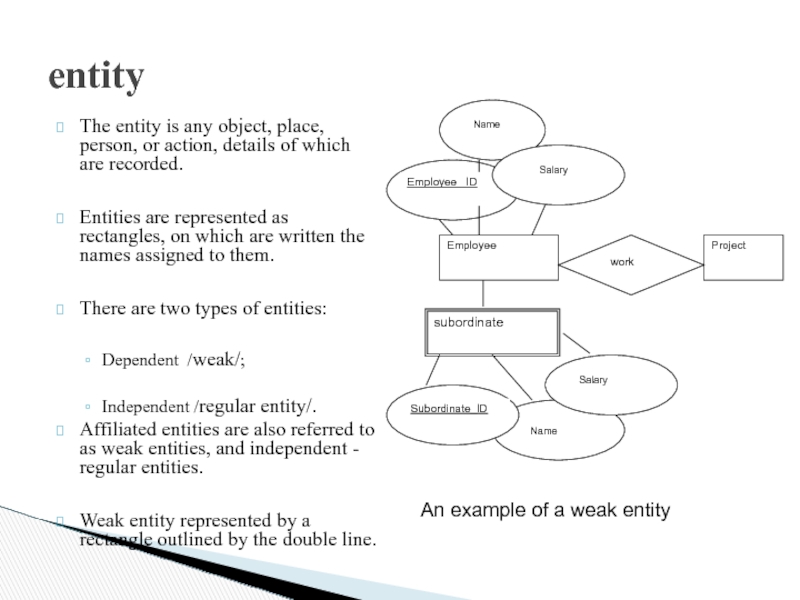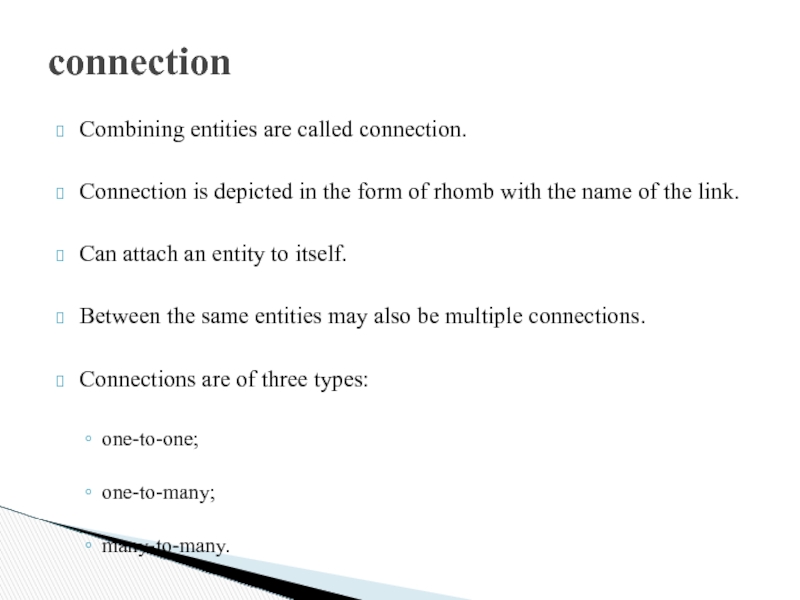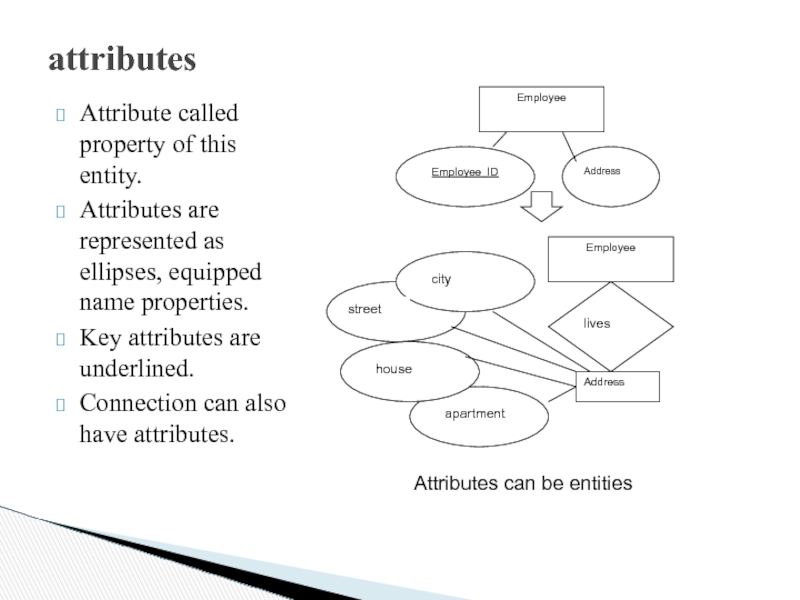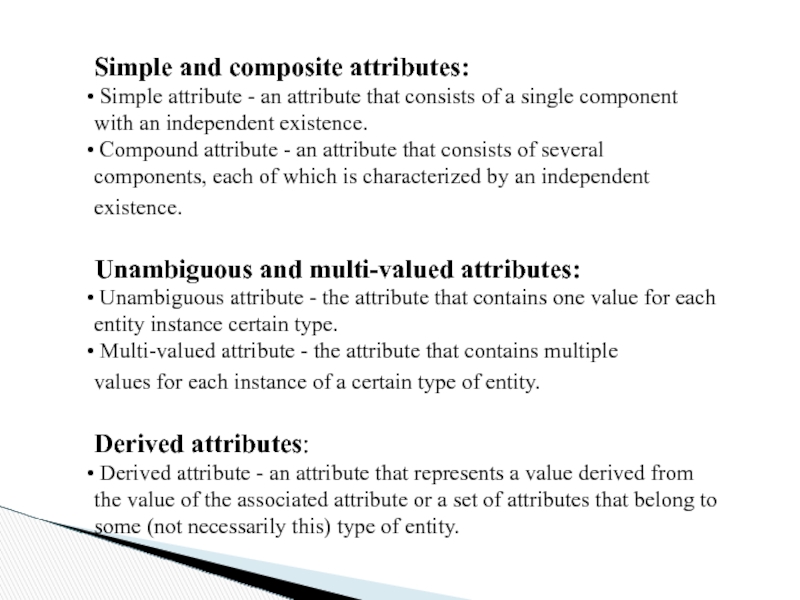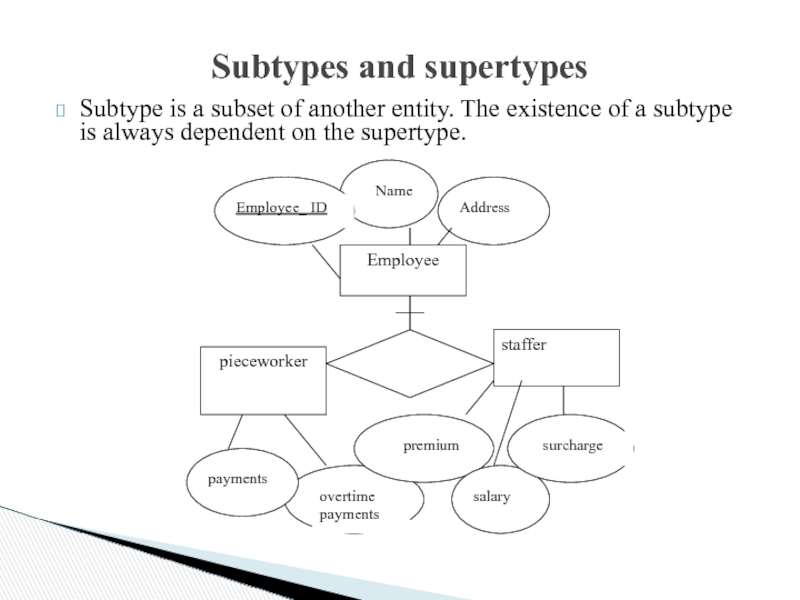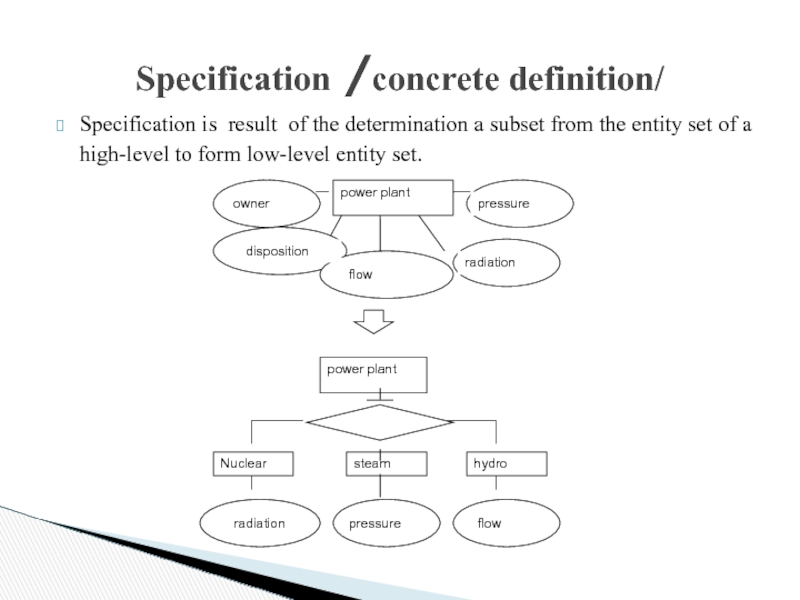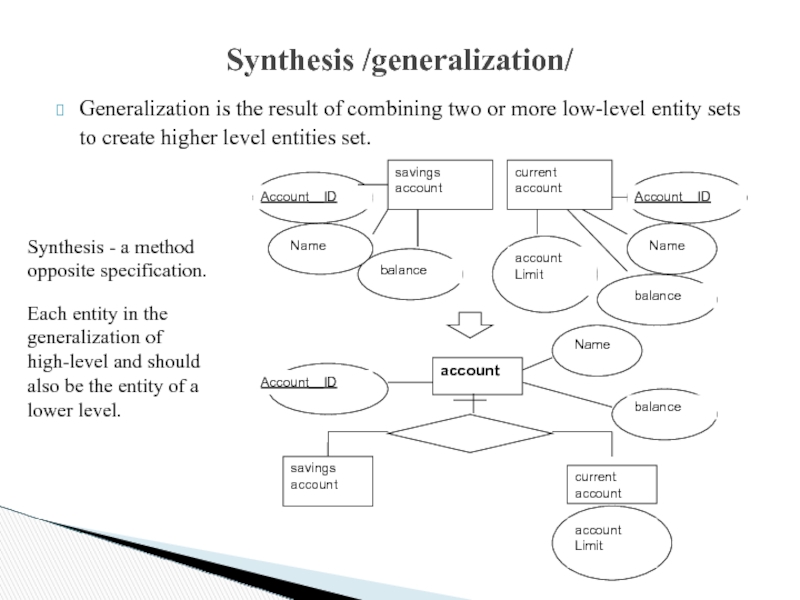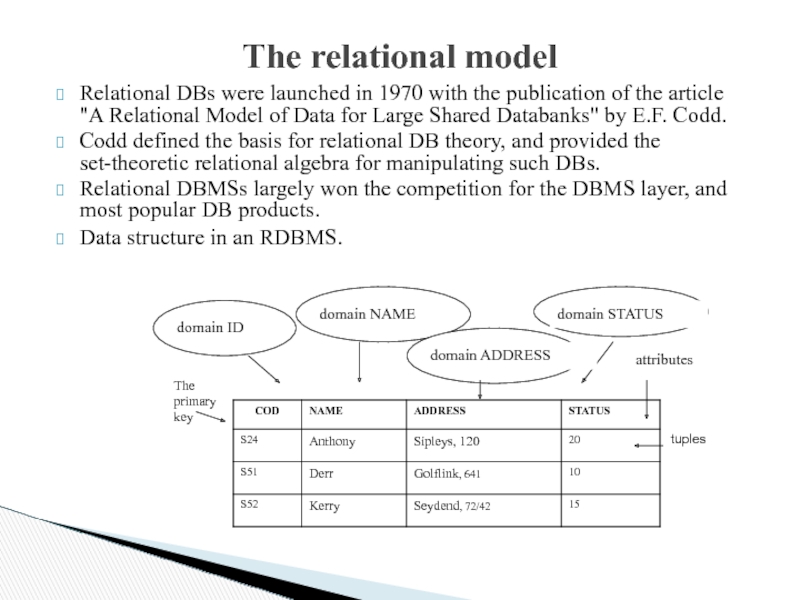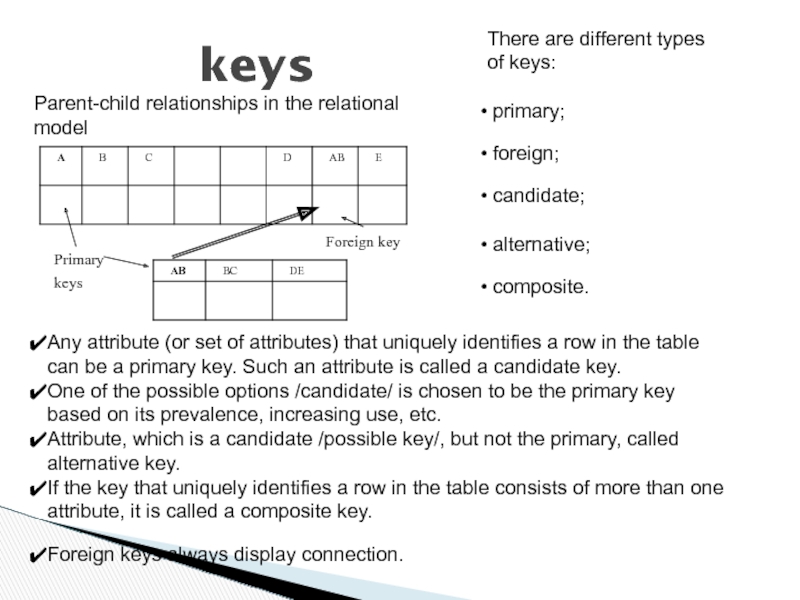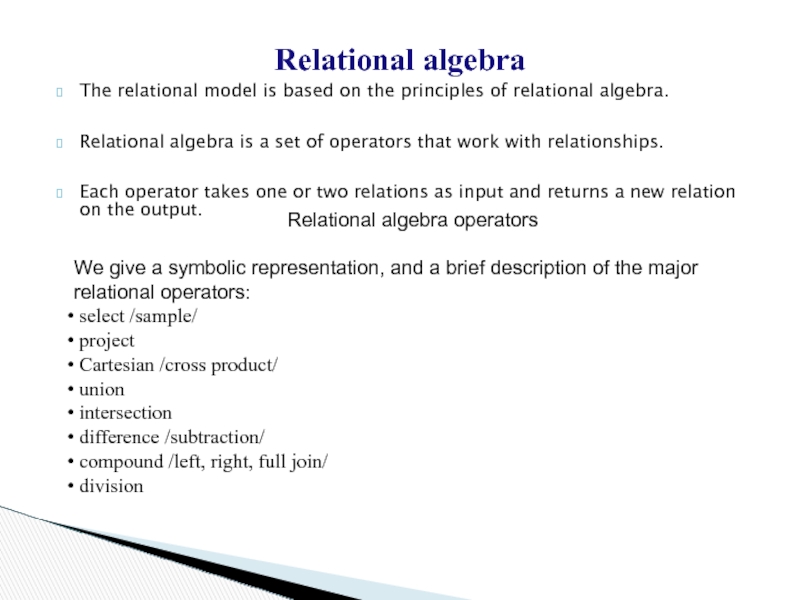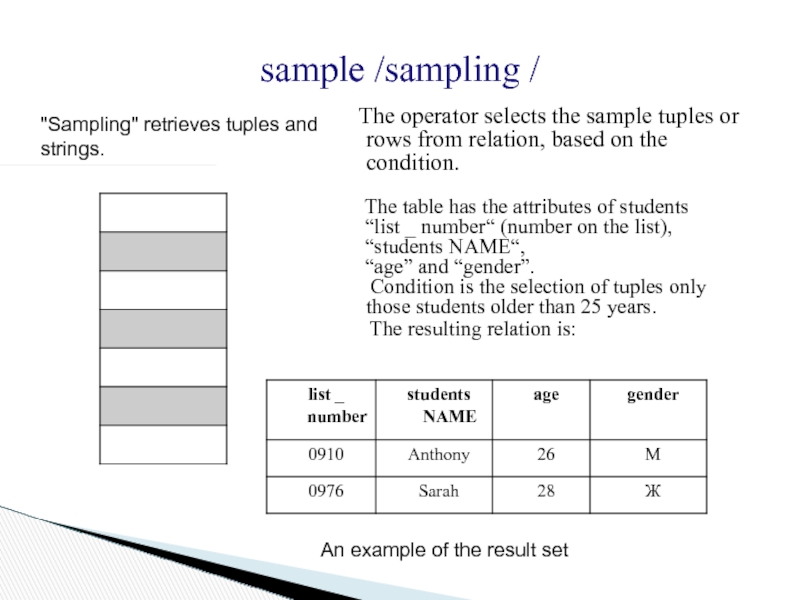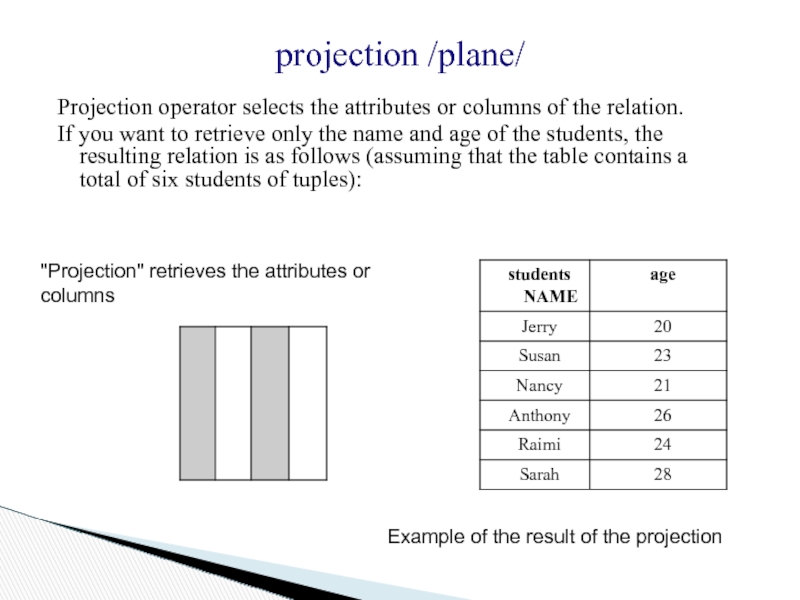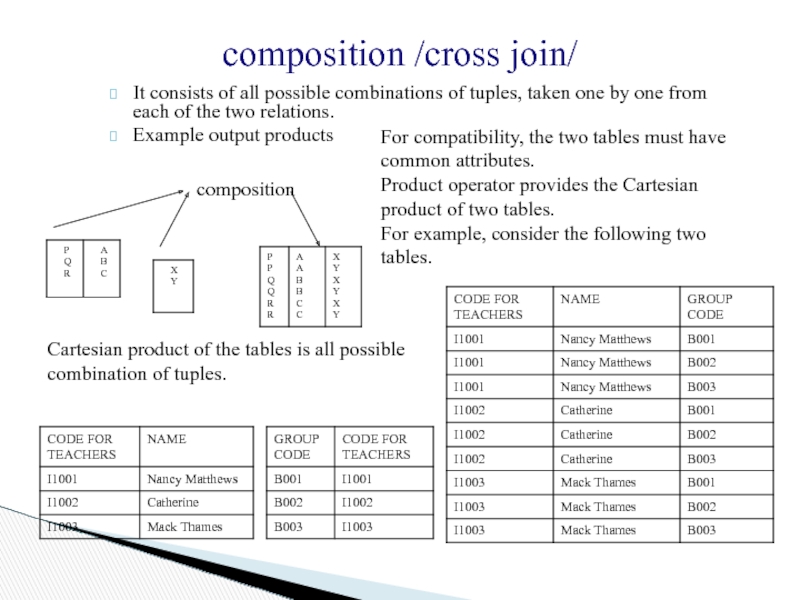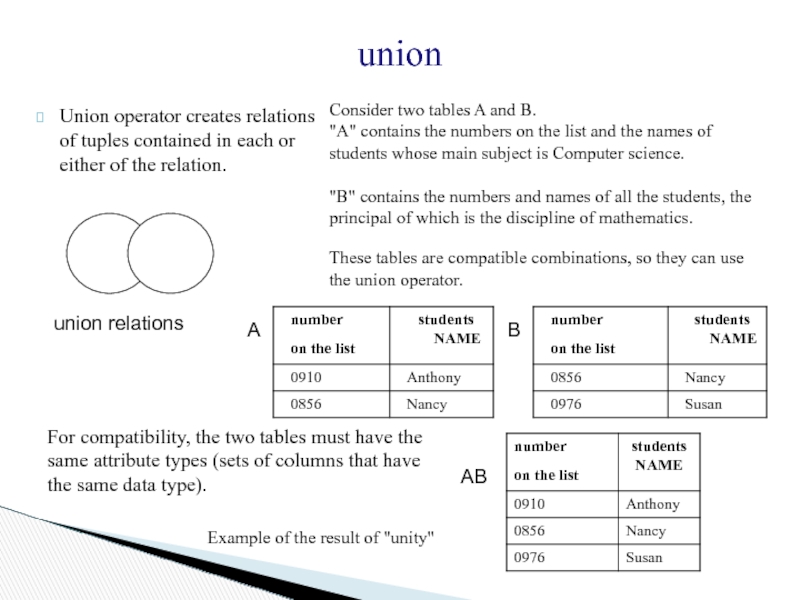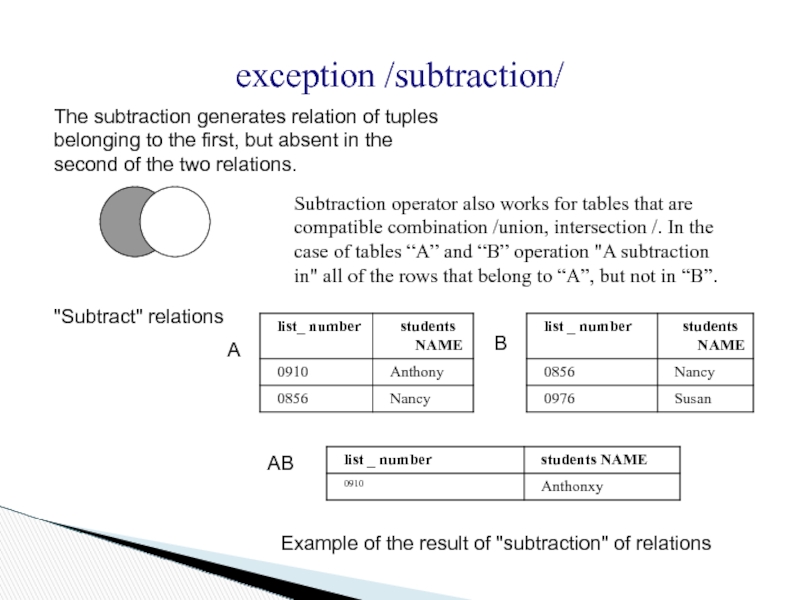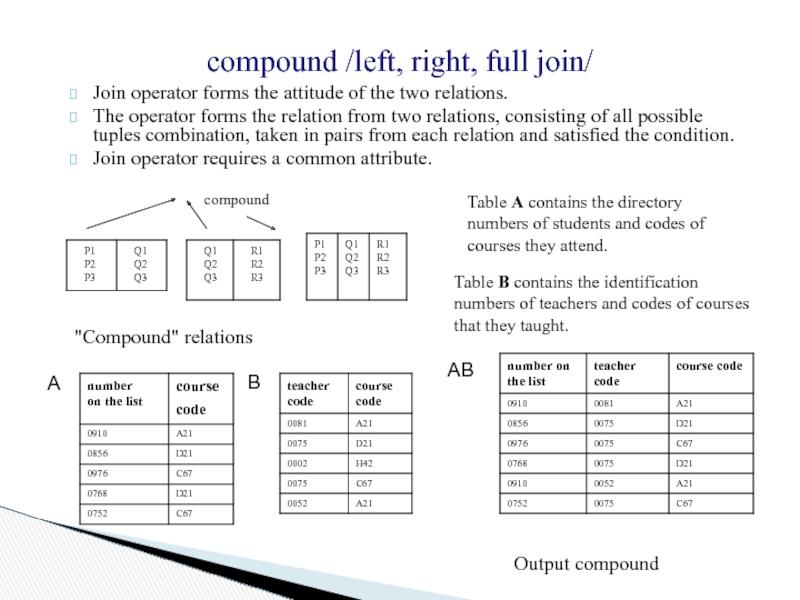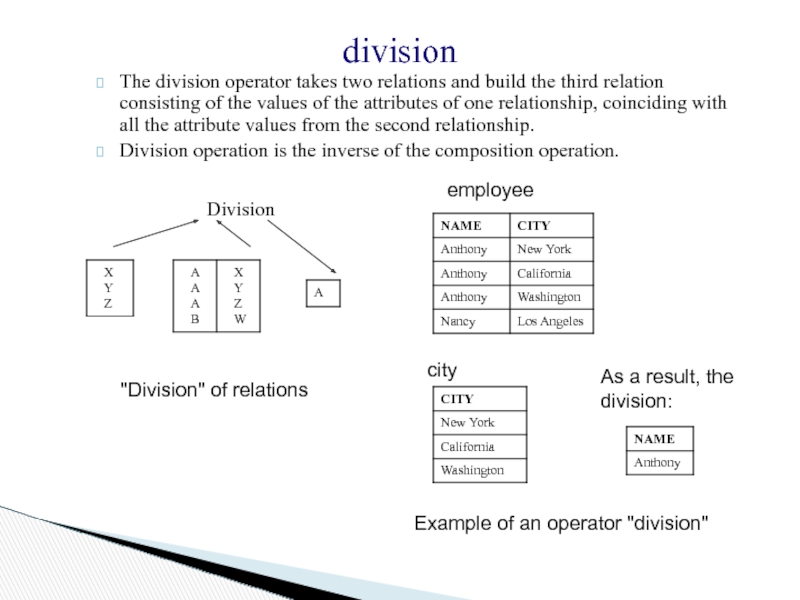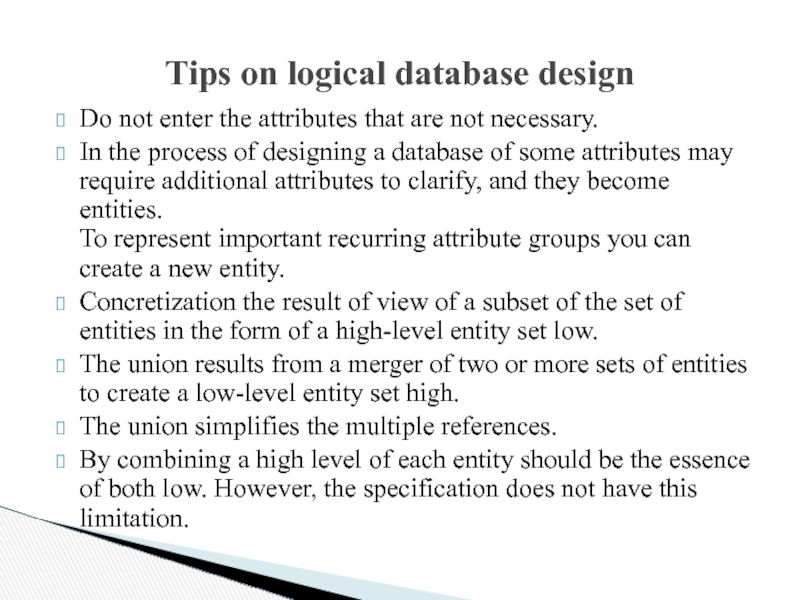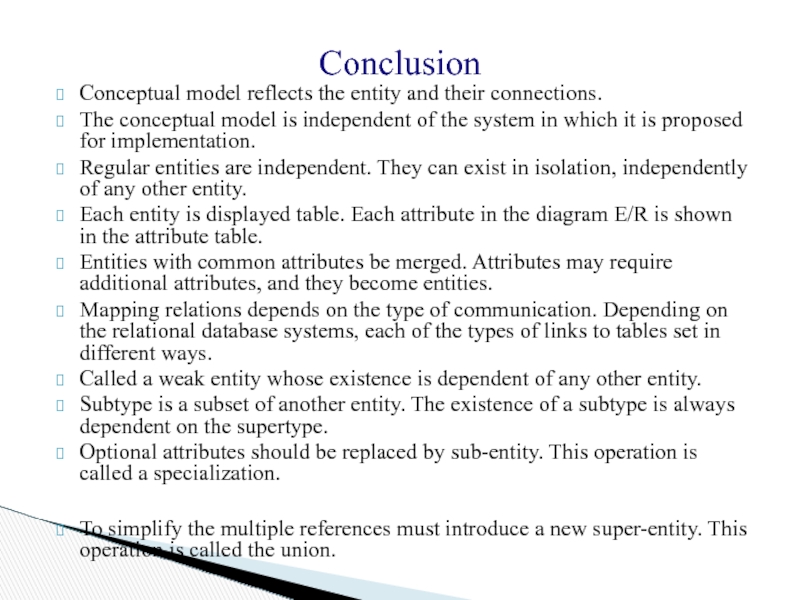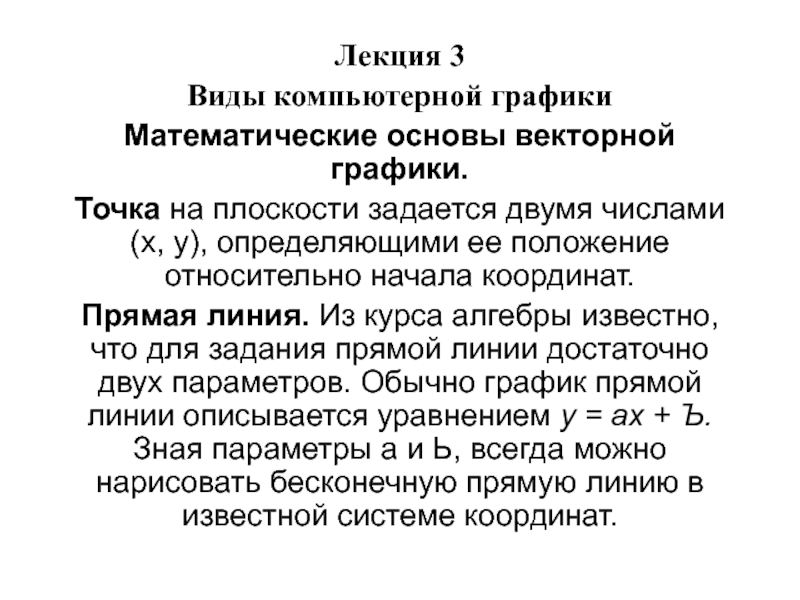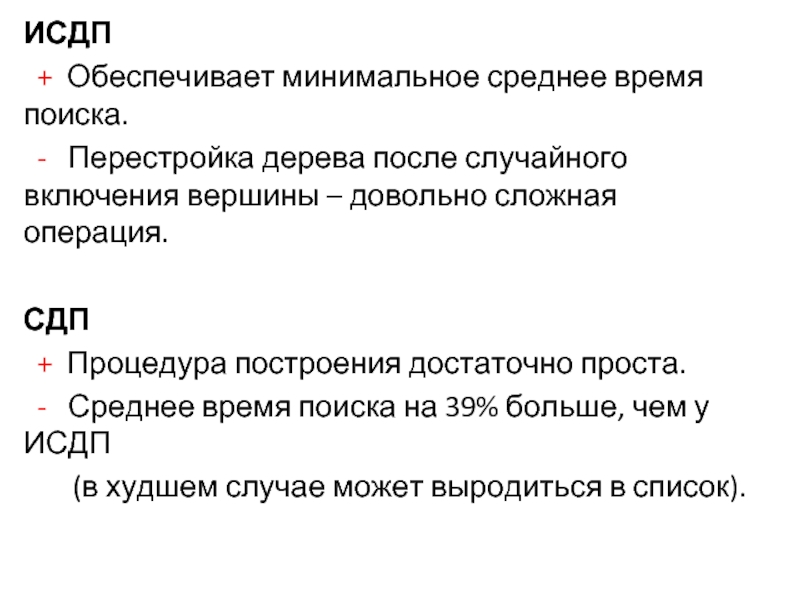- Главная
- Разное
- Дизайн
- Бизнес и предпринимательство
- Аналитика
- Образование
- Развлечения
- Красота и здоровье
- Финансы
- Государство
- Путешествия
- Спорт
- Недвижимость
- Армия
- Графика
- Культурология
- Еда и кулинария
- Лингвистика
- Английский язык
- Астрономия
- Алгебра
- Биология
- География
- Детские презентации
- Информатика
- История
- Литература
- Маркетинг
- Математика
- Медицина
- Менеджмент
- Музыка
- МХК
- Немецкий язык
- ОБЖ
- Обществознание
- Окружающий мир
- Педагогика
- Русский язык
- Технология
- Физика
- Философия
- Химия
- Шаблоны, картинки для презентаций
- Экология
- Экономика
- Юриспруденция
The relational model презентация
Содержание
- 1. The relational model
- 2. Questions to the previous lecture Data
- 3. conceptual design Conceptual
- 4. Model "Entity-Relationship" There are a variety
- 5. entity The entity is any object, place,
- 6. connection Combining entities are called connection.
- 7. attributes Attribute called property of this
- 8. Simple and composite attributes:
- 9. Subtypes and supertypes Subtype is a
- 10. Specification /concrete definition/ Specification is result
- 11. Synthesis /generalization/ Generalization is the result
- 12. Relational DBs were launched in 1970 with
- 13. Data structure in an RDBMS Organizing principle
- 14. keys Parent-child relationships in the
- 15. Relational algebra The relational model is
- 16. sample /sampling /
- 17. projection /plane/ Projection operator selects the
- 18. composition /cross join/ It consists
- 19. union Union operator creates relations of tuples
- 20. intersection Intersection operator creates
- 21. exception /subtraction/ "Subtract" relations
- 22. compound /left, right, full join/ Join
- 23. division The division operator takes
- 24. Tips on logical database design Do
- 25. Сonclusion Conceptual model reflects the entity
Слайд 1Lecture 3
Topics of the lectures
The conceptual model
Subtypes and
Specificity /concrete definition/
Synthesis /generalization/
Data structure in an RDBMS
Relational algebra
Major relational operators:
select /sample/
project
Cartesian /cross product/
union
intersection
difference /subtraction/
compound /left, right, full join/
division
Слайд 2Questions to the previous lecture
Data Model
What data models do you
Which model is historically the first?
Which model is the fastest data processing?
Which model is used for the analytic representation?
What models are based on strings, records?
Which model of the connection can’t be represented as a many-to-many?
Which model is the most advanced? Why is it so popular?
What can you say about each stage of the database design?
-Preliminary design -Analysis of feasibility -Determine requirements -Conceptual design
-Implementation -Testing and maintenance of the database.
Слайд 3
conceptual design
Conceptual model reflects the entities and relationships between
Conceptual model can be converted into a relational, hierarchical or network model.
The conceptual model is independent of individual applications, database management systems, hardware and physical storage method.
Data analysis is the first step in the development of the conceptual model, and it begins with the collection of data.
Data analysis includes the determination of entities, their attributes and the relationships between them on the basis of the data collected.
The next step is to check all of the operational use of the organization associated with their treatment, and avoid unnecessary or duplicate data.
After completing the analysis of the data, you draw a diagram of the "entity - relationship." This scheme provides an intuitive overview of the project and is particularly useful for the exchange of ideas among the users.
Слайд 4Model "Entity-Relationship"
There are a variety of object-oriented models. The most
Model "entity - relationship" is based on a realistic view which encompasses a set of objects or entities and their relationships.
Schema components of ER are:
entity ;
connection;
attributes.
Слайд 5entity
The entity is any object, place, person, or action, details of
Entities are represented as rectangles, on which are written the names assigned to them.
There are two types of entities:
Dependent /weak/;
Independent /regular entity/.
Affiliated entities are also referred to as weak entities, and independent - regular entities.
Weak entity represented by a rectangle outlined by the double line.
An example of a weak entity
Слайд 6connection
Combining entities are called connection.
Connection is depicted in the form
Can attach an entity to itself.
Between the same entities may also be multiple connections.
Connections are of three types:
one-to-one;
one-to-many;
many-to-many.
Слайд 7attributes
Attribute called property of this entity.
Attributes are represented as ellipses,
Key attributes are underlined.
Connection can also have attributes.
Attributes can be entities
Слайд 8 Simple and composite attributes:
Simple attribute - an
Compound attribute - an attribute that consists of several components, each of which is characterized by an independent existence.
Unambiguous and multi-valued attributes:
Unambiguous attribute - the attribute that contains one value for each entity instance certain type.
Multi-valued attribute - the attribute that contains multiple values for each instance of a certain type of entity.
Derived attributes:
Derived attribute - an attribute that represents a value derived from the value of the associated attribute or a set of attributes that belong to some (not necessarily this) type of entity.
Слайд 9Subtypes and supertypes
Subtype is a subset of another entity. The
Слайд 10Specification /concrete definition/
Specification is result of the determination a subset
Слайд 11Synthesis /generalization/
Generalization is the result of combining two or more
Synthesis - a method opposite specification.
Each entity in the generalization of high-level and should also be the entity of a lower level.
Слайд 12Relational DBs were launched in 1970 with the publication of the
Codd defined the basis for relational DB theory, and provided the set-theoretic relational algebra for manipulating such DBs.
Relational DBMSs largely won the competition for the DBMS layer, and most popular DB products.
Data structure in an RDBMS.
The relational model
Слайд 13Data structure in an RDBMS
Organizing principle of the relational database is
Relation is a set of elements called tuples. Visual form, a relationship is a familiar human readable two-dimensional table.
Table has rows (records) and columns. Each row has the same structure and is made up of fields. Lines correspond to the tuples, and columns - the attributes of the relationship.
Because, in a single table can’t be described more complex logical data structure of the domain, use the binding table.
Each table should have a column or combination of columns that uniquely identify each row in the table. This column (or columns) is the primary key.
A domain is a group of values from which one or more attributes (columns) calculate their actual values.
Слайд 14keys
Parent-child relationships in the relational model
There are different types
primary;
foreign;
candidate;
alternative;
composite.
Any attribute (or set of attributes) that uniquely identifies a row in the table can be a primary key. Such an attribute is called a candidate key.
One of the possible options /candidate/ is chosen to be the primary key based on its prevalence, increasing use, etc.
Attribute, which is a candidate /possible key/, but not the primary, called alternative key.
If the key that uniquely identifies a row in the table consists of more than one attribute, it is called a composite key.
Foreign keys always display connection.
Слайд 15Relational algebra
The relational model is based on the principles of
Relational algebra is a set of operators that work with relationships.
Each operator takes one or two relations as input and returns a new relation on the output.
Relational algebra operators
We give a symbolic representation, and a brief description of the major relational operators:
select /sample/
project
Cartesian /cross product/
union
intersection
difference /subtraction/
compound /left, right, full join/
division
Слайд 16
sample /sampling /
The operator selects the sample tuples or
The table has the attributes of students
“list _ number“ (number on the list),
“students NAME“,
“age” and “gender”.
Condition is the selection of tuples only those students older than 25 years.
The resulting relation is:
An example of the result set
"Sampling" retrieves tuples and strings.
Слайд 17projection /plane/
Projection operator selects the attributes or columns of the relation.
If you want to retrieve only the name and age of the students, the resulting relation is as follows (assuming that the table contains a total of six students of tuples):
"Projection" retrieves the attributes or columns
Example of the result of the projection
Слайд 18composition /cross join/
It consists of all possible combinations of tuples,
Example output products
For compatibility, the two tables must have common attributes.
Product operator provides the Cartesian product of two tables.
For example, consider the following two tables.
Cartesian product of the tables is all possible combination of tuples.
Слайд 19union
Union operator creates relations of tuples contained in each or either
union relations
For compatibility, the two tables must have the same attribute types (sets of columns that have the same data type).
Example of the result of "unity"
Consider two tables A and B.
"A" contains the numbers on the list and the names of students whose main subject is Computer science.
"B" contains the numbers and names of all the students, the principal of which is the discipline of mathematics.
These tables are compatible combinations, so they can use the union operator.
А
В
АВ
Слайд 20
intersection
Intersection operator creates a relation consisting of tuples belonging to
"Crossing" of relations
Consider Table “A” and “B”. Nancy examines two main disciplines. So her name appears in both tables. Intersection operator Tables A and retrieves the string that is common to both tables. Intersection operator works on tables that are compatible for the union.
Example of the result of "intersection" of relations
А
В
AВ
Слайд 21
exception /subtraction/
"Subtract" relations
The subtraction generates relation of tuples belonging to
Subtraction operator also works for tables that are compatible combination /union, intersection /. In the case of tables “A” and “B” operation "A subtraction in" all of the rows that belong to “A”, but not in “B”.
Example of the result of "subtraction" of relations
А
В
AВ
Слайд 22compound /left, right, full join/
Join operator forms the attitude of the
The operator forms the relation from two relations, consisting of all possible tuples combination, taken in pairs from each relation and satisfied the condition.
Join operator requires a common attribute.
"Compound" relations
Output compound
Table A contains the directory numbers of students and codes of courses they attend.
Table B contains the identification numbers of teachers and codes of courses that they taught.
B
А
AВ
Слайд 23division
The division operator takes two relations and build the third
Division operation is the inverse of the composition operation.
"Division" of relations
Example of an operator "division"
employee
city
As a result, the division:
Слайд 24Tips on logical database design
Do not enter the attributes that
In the process of designing a database of some attributes may require additional attributes to clarify, and they become entities. To represent important recurring attribute groups you can create a new entity.
Concretization the result of view of a subset of the set of entities in the form of a high-level entity set low.
The union results from a merger of two or more sets of entities to create a low-level entity set high.
The union simplifies the multiple references.
By combining a high level of each entity should be the essence of both low. However, the specification does not have this limitation.
Слайд 25Сonclusion
Conceptual model reflects the entity and their connections.
The conceptual
Regular entities are independent. They can exist in isolation, independently of any other entity.
Each entity is displayed table. Each attribute in the diagram E/R is shown in the attribute table.
Entities with common attributes be merged. Attributes may require additional attributes, and they become entities.
Mapping relations depends on the type of communication. Depending on the relational database systems, each of the types of links to tables set in different ways.
Called a weak entity whose existence is dependent of any other entity.
Subtype is a subset of another entity. The existence of a subtype is always dependent on the supertype.
Optional attributes should be replaced by sub-entity. This operation is called a specialization.
To simplify the multiple references must introduce a new super-entity. This operation is called the union.
